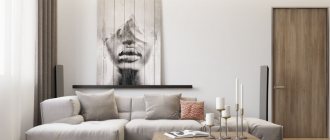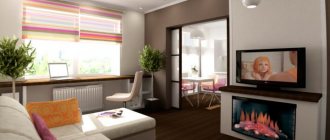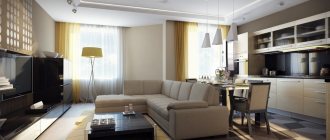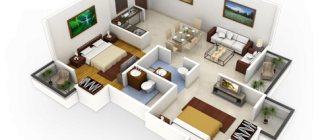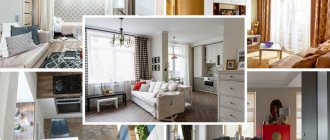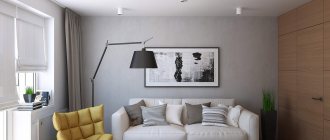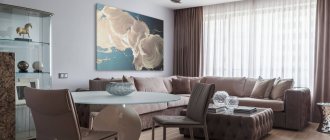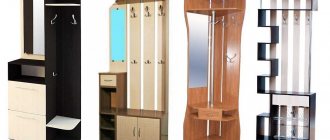Sunny yellow
An ideal option for a small room, especially if its windows face north. It is the yellow color that can attract warmth and comfort, while it will fit well into a modern, cheerful style. If you don’t want too bright shades, you should stick to pale options, which are perfect for vintage, art deco, retro, classic, etc. Of course, don’t forget about accents in textiles and decor.
Everything is in shades of gray
This color is unique due to its variety of shades. Even in monochrome, the living room will not look boring. Photographs, live plants, paintings and other decorative items will perfectly dilute gray colors, as well as a combination with orange, beige, yellow or blue. If you want to completely maintain monochrome in the decoration, you should use natural wood as the main material.
General principles of furniture arrangement
Any business begins with drawing up a plan. Furniture arrangement is no exception, and if you have a small room, even more so. Measure all its dimensions, the location of windows and doors, and mark it all on the plan. Decide on the functionality of each room; this will determine what furniture you will buy. Prepare paper cut out images of furniture.
When the preparatory stage is complete, determine the dominant element of your room and begin to “move” your paper layouts around the room plan. If you have the appropriate computer program, the task becomes much easier. There are three main ways to arrange furniture:
- Symmetrical - paired pieces of furniture are placed at the same distance from the dominant. The room looks strict and elegant. This method is ideal for interiors in a classic style. It is good for large square rooms. According to the conditions of the task, we have a small room, so it’s unlikely that such an arrangement will suit us.
- Circular - furniture is placed around a central piece of furniture. This arrangement also requires a large area, so we won’t dwell on it either.
- Asymmetry is the only suitable option. Furniture is arranged in a free order, without a special system, but nevertheless with obligatory observance of harmony. And here, too, it is necessary to determine the dominant piece of furniture.
With any method of arranging furniture, remember that there should be enough space for free movement around the room. The distance between pieces of furniture should not be less than 60 centimeters.
Here are a few more visual tricks that will help get rid of the feeling of cramped space.
- Give preference to compact multifunctional furniture models.
- Use light colors in decoration.
- Tall narrow cabinets visually enlarge the room.
- Mirror and glossy surfaces perform the same task.
- Where possible, replace swing doors with sliding ones.
- Do not overload the room with furniture and small decor.
This is all the ABC of design, it works flawlessly. Well, armed with this knowledge, we will begin arranging furniture in each room, depending on its functionality.
Decor and lighting
It’s worth thinking about lighting at the planning stage. A small but beautiful living room requires a special approach, since it is the easiest place to make a mistake, which will force you to redo the entire plan. Dark, poorly lit corners will make the room look gloomy and uncomfortable. Therefore, it is worth using several levels of lighting at once.
- Built-in chandeliers will emphasize the modernity of any solution and will visually increase the height of the ceilings.
- Spotlights will help you get rid of dark corners, especially in niches.
- Floor lamps and sconces will allow you to use light only in a certain area.
- Garlands and candles will create a romantic and intimate atmosphere.
- LED strips will interestingly emphasize the contours of paintings, photos, and objects of art.
It is important that each light source can be turned on separately. Often, all elements are combined into one remote control for maximum convenience (if such a system is possible in the apartment).
Use of decorative items
You need to be as careful as possible with this and find the perfect balance: the lack of pleasant little things and decor will lead to the living room looking uninhabited, and an excessive number of souvenirs, figurines, pillows and other things will take up all the free space.
There is no need to allocate a separate sideboard or rack for this. Decorative elements must fit harmoniously into the interior, so they are uniformly arranged without excesses. For example, above the sofa, only a painting or print will be enough, which in size will occupy about a third of the total length of the sofa. And in the center of the table a table souvenir would be appropriate. It is worth focusing on decorating the walls, since the floor space is already occupied by furniture, appliances and textiles.
Arranging furniture in a small bedroom
When arranging a bedroom, the most important thing is to achieve maximum comfort. We spend a third of our lives in this room; strength is restored here and a peaceful atmosphere should reign. Therefore it is important to consider:
- Square. For a bedroom for two, the norm is at least 9 square meters. If less, it is necessary to provide fresh ventilation.
- Passages around the perimeter of the bed. Ideally – 70 centimeters. But no less than 45.
- Sunlight should be present in the bedroom at least 2 hours a day.
- The location of the room - under no circumstances should it be a passageway. Don't place it near the kitchen either. Even if there is a powerful hood, you will not be able to completely get rid of food odors.
The main furniture in the bedroom is, of course, the bed. Therefore, the main task is to position it correctly. In a square bedroom, it is best to place the headboard against the wall. Bedside tables - on both sides. We will place an armchair and dressing table near the window.
In a rectangular bedroom, especially if it is narrow and long, it is advisable to place the bed along one of the long walls. Bedside tables can be replaced with shelves. Even the smallest bedroom needs local lighting near the bed - sconces or table lamps. You can completely abandon the large central light. Do you need a closet in the bedroom? Depends on its size. Of course it is desirable. For a small bedroom, buy compact models with a depth of not 60, but 30 cm. If not at all, then find a place at least for a chest of drawers. Linen needs to be stored somewhere, and it is better to do this in the bedroom. Here's what you can avoid in the bedroom:
- TV. It is not desirable even in a large bedroom - it is a strong irritant, and the bedroom is a place for relaxation.
- A workstation, a computer - do you really need it in the bedroom? Isn’t it logical to give this a corner in the living room, for example?
- Ottomans at the foot. Of course, this is convenient, but for a small bedroom it is still overkill.
For a small bedroom, the best furniture is a transforming sofa or a bed with a lifting mechanism.
Design Features
When thinking about the design of a small home, you need to follow several important principles.
- Everything should work to visually expand the space. Light colors, plain surfaces (or small low-contrast patterns), mirrors, and maximum natural light will help with this.
- Furniture should not be bulky. Instead of massive products, choose light and compact models with graceful legs. Use suspended structures whenever possible.
- With limited footage, zoning decides everything. With its help you can turn one room into two or even three. At the same time, it is important not to clutter the space and not block the light. Instead of blank false walls and solid partitions, use slats with gaps, low screens or transparent glass screens. Doors can be replaced with arches and wide openings.
- The simpler the finish, the better. It should be a neutral background that blurs the actual boundaries and does not draw attention to the actual size of the rooms.
- Make the most of the usable space: mezzanine cabinets in the kitchen, an insulated loggia as an addition to the living room, storage under the bed, podiums, niches, etc.
Instagram @cubiqstudio
Instagram @projection_design
Instagram @sonyachernykh_
Instagram @destiny_dizain
Instagram @ivanova_interiors
Instagram @cubiqstudio
Instagram @andrii.ortynskyi
Arranging furniture in the nursery
We furnish the children's room with special love. It should please the baby and help his emotional development. A particular difficulty is that even in a very small room it is necessary to allocate several zones - for play, for relaxation, for study. All these zones must be clearly marked and not flow into one another. First of all, let's remember the basic requirements for children's furniture. She must be:
- Safe, that is, without sharp corners and securely attached to the wall.
- Eco-friendly, that is, made from environmentally friendly materials that do not emit any toxic substances.
- Lightweight and durable.
- Functional.
What should be in a children's room? There is a bed in the sitting area. It should be spacious, with high sides; we place it near the wall away from the window. This way the child will intuitively feel protected. If there are two children in the room, a bunk bed would be appropriate. To save space, a good option is a loft bed, where there is a study area below - a table with chairs and bookshelves, and a place for relaxation at the top. Just make sure that the bed is at least 1 meter from the ceiling. Place the study area - desk, bookcase, shelving near the window, here you need more light.
It is better not to mix the play area with either a relaxation area or an activity area. There should be a bedside table for toys, a small table for modeling, drawing, and so on, and a carpet on the floor for comfortable crawling. An older child can have a sports corner in this area. A children's wardrobe can be placed at the border of the zones. The interior of the nursery is changing quickly; it “grows up” along with the child. The best option is multifunctional transformable furniture.
Setting up a small office
Of course, not everyone can boast of a home office. But if you are one of these lucky ones, then your task is to make it as convenient and suitable for work as possible. In order for you to work well, your workplace must meet all the requirements of ergonomics and aesthetics. A beautiful office inspires fruitful ideas.
We choose a place for the office where you will not be disturbed often, preferably away from the kitchen so that you are not distracted by delicious smells. In the office, of course, the solo part is played by the desk or computer desk; if possible, place it closer to the window. Chairs, shelves for books and CDs. All furniture is good quality and multifunctional. There should not be anything unnecessary that distracts you from work. It is better to remove bright posters and bulky souvenirs. Black and white photographs and green plants are allowed. However, there can be no universal recommendations here. Everyone settles in the way that is most convenient for him. Only a recommendation for organizing lighting can be universal. The workplace must be well and properly lit.
Photo gallery
Our gallery presents photos of the best projects that will inspire you to implement bright and unconventional ideas in a small living room.
How to arrange a small kitchen
In any home, the kitchen is the center of attraction. Life is in full swing here. The main character is often the kitchen unit. Manufacturers make either linear or corner models for different kitchens. Linear - all the furniture is in one row. For small kitchens, sometimes the only possible option. To fit everything that is required, we use walls along the entire vertical, wall cabinets up to the ceiling. Upstairs we put away those things that we use very rarely.
We adapt a window sill under the tabletop. A corner set is also suitable for small kitchens. It is more expensive than a direct one, but it allows you to make the most of the space, including the corner. Use all sorts of “cunning” devices for storage: a carousel system, secret shelves, more retractable and lifting structures. The latest advances in household appliances and organization of storage systems will help save space. Use built-in technology.
The kitchen, without a doubt, should have a stove, sink, work surface, and refrigerator.
Tall cabinets mounted to the ceiling will accommodate a lot of utensils and make the room visually larger. The dining area can be successfully replaced by a wide window sill or a bar counter. Don't forget about the roof rails. They will help you keep in order thousands of little things that should always be at hand. Use folding and reclining furniture.
Design tricks will also help make the kitchen lighter and more spacious: light colors and glossy furniture facades, organizing proper lighting, avoiding bulky furniture and thick curtains, carefully thought-out storage organization - use any crevice.
And, most importantly: the kitchen should be as convenient as possible for the one who spends the most time in it preparing food. Therefore, all furniture must be “fitted” taking into account ergonomic requirements.

